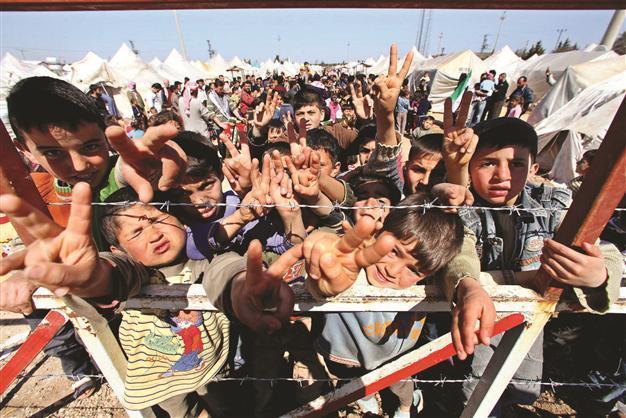Syria arms exports up
DAMASCUS / STOCKHOLM

Syrian kids taking refugee in a border camp in southern Turkish province of Antakya’s Reyhanlı district make a victory sign beyond the fence. The number of Syrians residing in reached nearly 16,500, the General Directorate of Natural Disasters says. AA photo
Syria imported nearly six times more weapons in 2007-2011 than in the previous five-year period, with Russia accounting for 72 percent of the arms supplies to President Bashar al-Assad’s regime, according to the report.
It did not specify the volume of weapons exports after the start of the uprising in 2011. Major Russian arms deliveries to Syria in 2007-2011 included air defense systems and anti-ship missiles, which have no direct use in the current unrest in the Arab state. But they have upgraded the regime’s capability to defend against outside intervention, SIPRI researcher Pieter Wezeman said. Syria’s weapons imports rose 580 percent from the 2002-2006 period, lifting the country from No. 68 to 33 in the rankings of the world’s arms importers, SIPRI said. Nineteen percent of Syria’s arms imports came from Belarus and 9 percent from Iran.
Russia 'positive' on aid truce amid fatal clashes
The Red Cross chief said Russia shows ‘positive indications’ on a daily truce proposal in Syria, as deadly clashes reach an upscale neighborhood of Damascus
Syrians pray during a funeral service for some 27 people who were killed in two bomb blasts the previous day at the Othman mosque in Damascus on March 18. Anatolia news agency says more than 80 people were killed across Syria on March 19.
ussian Foreign Minister Sergei Lavrov yesterday gave “positive indications” to the Red Cross on proposals for a daily two-hour halt in fighting in Syria, in order to allow for life-saving aid operations. Dozens of people have reportedly been killed across the country over the past two days.
Jakob Kellenberger, of the International Committee of the Red Cross (ICRC), held a meeting with Lavrov yesterday in Moscow, to ask Russia to help persuade Damascus to allow more access for humanitarian aid to civilians.
“The ICRC received positive indications of support on its operational priorities and its initiative for a two-hour cessation of fighting on a daily basis,” ICRC spokesman Hicham Hassan told Reuters in Geneva. Beyond the aid truce proposal, the pair also “discussed the importance of neutral and independent humanitarian action in Syria,” Hassan said.
Meanwhile, Anatolia news agency said yesterday that at least 86 Syrians had been killed in clashes and bomb attacks in the Mazzeh district in west Damascus.
The death toll was not confirmed by other sources. At least three “terrorists” and a member of Syria’s security forces were killed in a clash in a heavily-guarded district of Damascus yesterday, state television and monitors reported. A resident of the western Mazzeh said that the clash was close to the Swiss embassy and the home of Maj. Gen. Assef Shawkat, the deputy chief of staff for security affairs.
UN teams cautious on visits
The two separate humanitarian teams visiting Syria were keeping their locations secret for safety reasons, as the country continues to be shaken by fierce clashes and explosions. A team of five experts, sent by the U.N.-Arab League envoy for Syria, Kofi Annan, arrived in Damascus yesterday to discuss proposals to deploy international monitors in Syria. Ahmad Fawzi, a spokesman for Annan said he could not disclose the team’s “precise plans or location,” and that Annan’s next visit to Syria would “depend largely on progress being made by the Syrians in working with the mission.”
The U.N. and the Organization for Islamic Cooperation (OIC) yesterday called on Syrians to respect the “neutrality” and “safety” of their humanitarian aid mission, according to a joint statement, Agence France-Presse reported.
















